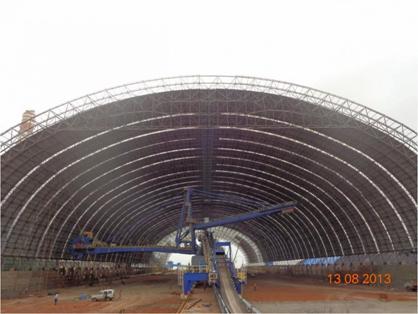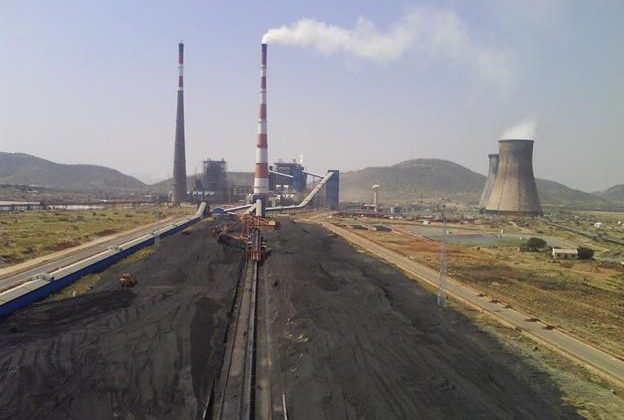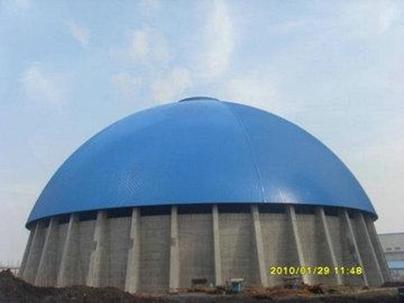SUMMARY: This paper gives the aspects of the coal stockpiles sheds or coal stockyard sheds presently in trend in the Indian power plants and the recommended improvements. About 65 % of the power generation in India is by coal base power plant. Those coal based power plants are spread throughout India viz. close to the pit head, near the ports and inside the interiors a long way far from the mines and ports. Maximum of the power plants has coal stockpile of capacities starting from 7 days to 45 days requirement of the power plant.
The majority of the coal stockpiles sheds inside the Indian power plant are open type built via the rail mounted stackers. This kind of open stockpiles poses many environmental dangers. This paper discusses the improvement in the stockpiling system within the thermal power plant.
INTRODUCTION
The majority of the coal stockpiles sheds in the power plants are open type formed by the rail mounted, slewing type stackers. The capacity of the coal stockpiles sheds ranges from 7 days to 45 days requirement of the power plant. In terms of tonnage, this would be about 50,000 Tones to 800,000 Tones
The installed capacity of the coal based power plant in India is about 130,000 MW. The consumption of coal per annum is 480 million TPA. About 85 million TPA of coal is imported. These Power Plants are placed in different part of India. A few are placed near the pit head, a few near the ports and the relaxation within the interiors a long way away from the mines and ports.
A majority of the coal stockpiles in the power plants are open kind Built by the rail mounted, slewing type stackers. The capability of the coal stockpiles sheds variety from 7 days to 45 days requirement of the power plant. In terms of tonnage, this will be approximately 50,000 Tones to 800,000 Tones
COAL STORAGE AND TRANSPORT IN THE POWER PLANT:
Storage of coal in the stockpile is necessary to take care of any disruptions in the transport system or in the coal mines due to which coal cannot be received at the power plant on such days. The general practice is to provide a 7 /15 days stockpile in case of a pithead power plant depending on the reliability of the mines and the conveying system. In case the power plant is far away from the coal mines, coal stock of 30 days requirement will be provided. In case coal is received by ships, the stockpile of 45 days capacity will be provided, as the reliability of shipping will be less due to variations in the weather conditions especially during the monsoon period.
Coal will be transported to the power plant through belt conveyors in the case of the pit-head power plant. In the case of power plants located far away from the mines, coal will be transported by using rail.
In a few instances, coal from the mines can be transported by means of ships to the nearest port and from there it will be transported both through belt conveyors and by way of rail depending on the distance of the power plant from the port. In the case of imported coal, the same will be transported to the nearest port by using ships, from where coal will be transported to the power plant both by means of belt conveyors and by rail. Coal as a consequence obtained at the power plant can be unloaded, crushed if required to the desired size after which stored inside the stockpile or stockpile shed.
Coal Storage within the stockpile is essential to take care of any disruptions within the delivery system or within the coal mines due to which coal cannot be received at the power plant on such days. The overall exercise is to offer a 7 /15 days stockpile in case of a pithead power plant depending on the reliability of the mines and the conveying device. In case the power plant is far away from the coal mines, coal inventory of 30 days requirement might be provided. In case coal is acquired with the aid of ships, the stockpile of 45 days ability might be supplied, as the reliability of shipping could be less because of variegation in the weather situations particularly throughout the monsoon period.
TYPES OF STOCKPILE:
The coal stockpile in almost all the power plants will be established rail mounted, slewing and luffing type stacker. The stockpile build via this may be either triangular form or trapezoidal form. In a few power plant, where the storage capability is much less (say 50,000 T), the stockpile can be shaped by using telescopic chute arrangement and through napping. The stockpiles might be of open type
PROBLEMS WITH THE EXISTING STOCKPILE SYSTEM:
There are several problems being faced with the present type of open stockpile system. The major problems are listed below:
- Fugitive dust nuisance from the stockpile due to wind
- Spontaneous combustion of coal in the stockpile
- Air pollution
- lump formation of minerals from moisture/rainfall
Due to the fugitive dust emission from the stockpile, the dust particles will be carried by the wind and causes pollution. This would pollute the plant area and could cause damage to the other utilities like cooling towers, switch yard etc. in the power plant. In some of the plants, these stockpiles are close to the boundary of the plant, the coal dust particles carried by the wind causes dust nuisance in the neighbouring villages.
Useful coal is lost due to wind erosion and the quantity of such loss would depend on the location of the stockpile and weather conditions. In the port area where strong winds are experienced for a majority of the time, this loss will be high.
CASE STUDY: SINGRAULI – THE ENERGY CAPITAL OF INDIA
The Singrauli region spreads across the states of Uttar Pradesh (Sonebhadra district) and Madhya Pradesh (Sidhi and Singrauli districts) and has been for a long time promoted as India’s energy capital. Today Singrauli’s landscape hosts some of the oldest thermal power stations and operational coal mines in India. There is also an aluminium smelting plant and other industrial and commercial operations. The social and demographic profile of the area has undergone a significant transformation with the massive industrial changes to the landscape.
Singrauli’s thermal power plants release about 720 kilogrammes of mercury per year. The UN cited an Indian Central Pollution Control board estimate that “17 percent of power plant mercury emissions are from the Singrauli region.” Fly ash, the by-product of coal combustion, is also a significant problem. The coal-burning power plants release about six million tonnes of fly ash a year, making land unfit for cultivation. In parts of Singrauli, the fly ash lies in piles five feet thick. This study found Singrauli (both in MP and UP) to be “critically polluted”, with an overall index of 81.
So, in the open stockpile, the spontaneous combustion of the coal would take place due to the voids in the pile and free flow of air. The spontaneous combustion of coal in the stockpile results in the degradation of the coal and causes changes in the physical and chemical properties of the coal. There could be a risk of the dust explosion in the pulverises and coal silos. Due to spontaneous combustion and heating of coal in the stockpile, the GCV of coal would also reduce and some quantity will be unsuitable for the intended use and causes economic loss. The performance of combustion in the furnace would also be seriously affected.
Wind and moisture in the coal play a major role in the spontaneous combustion of the coal. The Wind supplies more oxygen for combustion. When the coal absorbs moisture, heat is generated. This heat increases the temperature of the coal. Hence the addition of excessive moisture for suppressing the dust / fire shall be avoided.
During the spontaneous combustion of coal, some gases would be produced. This gas is also carried by the wind and causes pollution in the surrounding environment.

DUST CONTROL AND FIRE FIGHTING SYSTEM
Plain water type sprinkling system will be provided along the stockpile for suppressing the dust. A lot of water is being poured for dousing the fire due to spontaneous combustion in the stockpile. The Huge quantity of water will be consumed every day for these purposes. This should be avoided, as excessive moisture in the coal would aid heating of the coal.
PROBLEMS DUE TO RAINWATER:
During the rainy season, rainwater falling on the open coal stockpiles sheds will add more water. Handling of the coal becomes difficult as the wet coal chokes the chutes and sticks to the belt and causes dusting all along the return belt if the scrapping is not effective.
The excess water needs to be drained and collected in the coal pile runoff the pit. Water contaminated with the coal fine particles will be allowed to settle in the coal pile runoff pit where coal particles will be separated and clear water will be reused in the plant. In this process, useful coal will be washed out and causes product loss.
ALTERNATIVE SYSTEMS OF STORING THE COAL:
In view of the problems faced in the open type stockpile, several alternative methods of storing the coal in the power plants are evaluated. The following are the various major types of coal storage.
- Longitudinal covered shed with conventional rail mounted Stacker cum Reclaimer.
- Dome type structural storage shed with circular Stacker and Reclaimer.
- Barrel Vault Structure Storage Shed
- Alcox Space Structure Systems
- Space Frame Structure Shed
- Wind barriers around the stockpiles with conventional rail mounted Stacker cum Reclaimer.
- Large capacity silos.
LONGITUDINAL COVERED SHED:
In this case, coal stockpiles sheds will be formed by the conventional rail mounted stacker cum reclaimer. The entire stockpiles and the Stacker cum Reclaimer machines will be covered within the shed.
Covered storage shed for the conventional coal stockpile
DOME TYPE COVERED SHED:
In this type of structure, the shape of the shed will be in the semi-hemispherical form. There will be a concrete wall up to a certain height from the ground level and the structure(coal stockpiles sheds) will be erected above this wall. The dome structure of various sizes could be adopted depending on the storage required. A circular sticker and scraper type reclaimer could be used for reclaiming the coal.
With this type of shed, coal will be protected from wind and rain and hence the problems associated with these will be avoided. This kind of storage shed/coal stockpiles sheds can accommodate the higher quantity of coal in a smaller area as the height of stockpile could be increased. The footprint required for this type of shed would be lesser compared to a longitudinal stockpile for an equivalent capacity.
Dome shaped covered structure for the coal stockpile
WIND BARRIERS AROUND THE STOCKPILE:
The wind barriers could be provided around the stockpile to avoid the wind blowing on the stockpile. With this, it is possible to reduce the problems faced due to the wind like spontaneous combustion and pollution due to the carryover of the dust and gas from the stockpile. However, the problems due to the rain water will still remain as the same cannot be contained.
The wind barriers are of structural steel framework and the cover will be of geotextile material or colour coated sheets. This will be designed for the maximum wind speed in the plant area. Typical detail of the barrier is furnished below.
LARGE CAPACITY SILOS:
Large capacity silos could be used for storing the coal. With this, it is possible to reduce the problems faced due to wind and rain. The silo system has many advantages few of them are furnished below:
The footprint of the silo system will be less as compared to both the types of sheds and hence it will be advantageous where there is a constraint for the land. The filling of the coal could be more uniform in the silo with the use of a mechanical device and hence segregation can be avoided. The accessibility of oxygen is very limited and hence spontaneous combustion and heating of coal is greatly reduced. Monitoring of various types of gases like CO, NH4 etc can be done continuously. The blending of different types of coal if required could be done with better accuracy with the controlled extraction from different silos.
For storing a higher quantity of coal, more number of silos needs to be provided. The overall economics of the silo system with other covered shed needs to be worked out on the case to case basis.
ALCOX SPACE STRUCTURE SYSTEMS:
Alcox space structure can be formed in any kind of structure such as dome structure, barrel vault structure or any kind of other structure as per the requirement of clients. As barrel vault is composed of member elements arranged on a cylindrical surface which can be used to cover coal. It can be built with a span of up to 200 m, the height of up to 40 m and any length. We believe it has a major application in the Cement plants, Thermal power plants, Mines to cover the coal stockpiles, limestone stockpiles and minerals.

Our Structure is Improvised Space Frame Structure
Why Alcox Space Structure Frame?
- Save cost compared to conventional structures
- Fast Erection without interrupting the plant functionality
- Wide spans up to 150 meters
- Customised as per requirement
ADVANTAGES
- It complies with current MOEF/NGT guidelines
- Prevents loss of GCV (Gross Calorific Value)
- Protects Spontaneous combustion of coal
- Protect loss due to erosion / Air pollution
- Prevents lump formation of minerals from moisture/rainfall in the open storage.
- More workable coal / Limestone due to low total moisture.
- Solar panels can be mounted on our structure leading to higher space
- Utilisation, without incurring an additional cost of the mounting structure. Bonding of high moisture coal in Coal yard
Looking at the above advantages, there will be huge savings on the operational cost as the well substantial increase in power generation due to the improvement of GCV, reduction in surface moisture and more workable coal. Moreover, the structure(coal stockpiles sheds) will prevent loss of minerals which go to waste due to lump formation caused by absorption of moisture in open storage. Hence, it will save huge cost to the exchequer and will improve the efficiency of power plants and prevent loss of minerals.
Why Hindustan Alcox?
- More than 20 Years of Experience in Specialised Steel Structures.
- Working on a similar shed enquiry with UltraTech Cement
- 22 Airports, Sheds etc built across India
- In-house Design, Fabrication and Erection
- Commitment, Quality Work, Timely completion
We are the space frame manufacturers in India
CONCLUSIONS
The open type coal stockpiles sheds in the Indian power plants has many problems as detailed above. The pollution of the surrounding area is the main concern especially where the plant is located in the inhabited places. It is observed that closer to the older power plants, many villages have developed recently. In the new power plants, it is difficult to get the required land and the villages that are existing around the proposed power plants cannot be disturbed. Hence, it is essential to protect the environment for the people working in the plant and also the people living outside the power plant.
By Covering the Coal Stockpiles Sheds in the plant , the operating expenses of the power plant will also be lower. The loss of coal due to spontaneous combustion, erosion due to wind and rain from the stockpile could be reduced with the covered storage. The capital cost and operating costs could be worked out specific to each project and economic feasibility can be assessed. It is recommended to provide the covered storage for the coal stockpile in the power plants.



